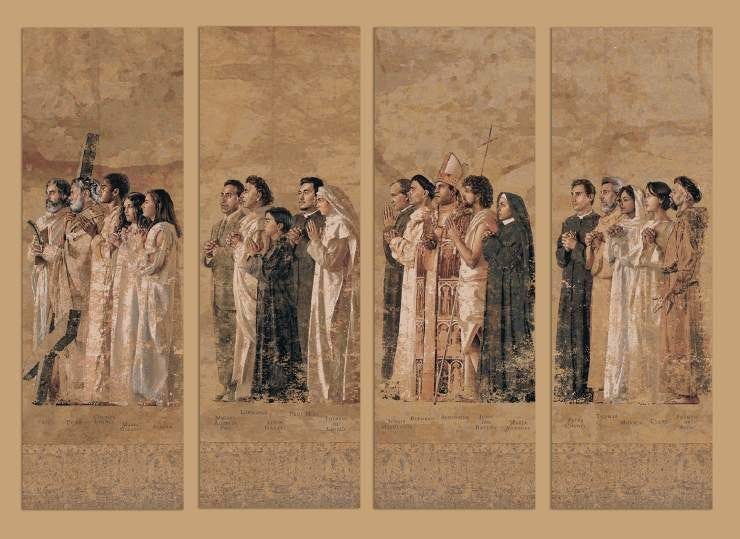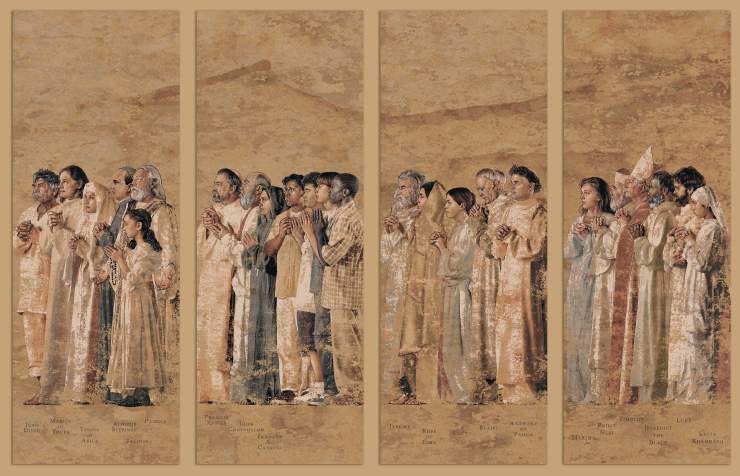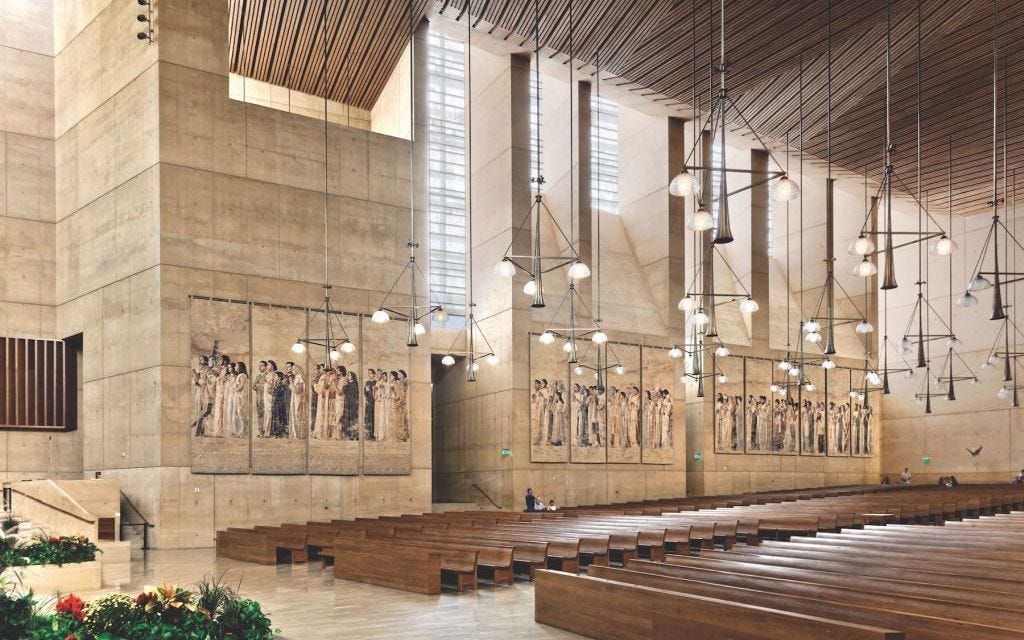Seeing the crowds, he went up on the mountain, and when he sat down, his disciples came to him. And he opened his mouth and taught them…
Matthew 5:1-2 (ESV)

Nava, John. Tapestries for the Cathedral of Our Lady of the Angels. 2002, Cathedral of Our Lady of the Angels, Los Angeles.
This week’s artwork is a series of tapestries depicting the “communion of the saints” in Los Angeles’ Cathedral of Our Lady of the Angels. Saints from throughout time are interspersed with everyday people as a reminder of “the many anonymous holy people in our midst” (see below for link). Each person’s eyes are facing the cross at the front of the cathedral, and this verse from Revelation is sewn into the tapestries: “See, God's dwelling is among mortals. God will dwell with them. They will be God's people and God will be with them” (21:3). These tapestries felt incredibly fitting as we begin our journey with Jesus and the people who surrounded him. (You can read more about the tapestries here.)
Introduction
Hey friends!
Welcome to the Beatitudes! I’m really excited to spend the next few newsletters breaking down the “inverse Kingdom of God”—a Kingdom filled with the people you wouldn’t fully expect to be there. This week we’re focused on the first two verses, the verses that set the stage for everything that comes after.
Below the main reflection for today, I’ve included a four key observations from various scholars/commentaries that help illuminate and situate these two verses as we prepare to enter the Beatitudes. I’ll also be posting books for further artistic reading on the Slow Faith Instagram over the next few weeks!
Originally, I was going to also include links to articles I’ve been reading, an album I’ve been listening to, and new additions to the playlist, but the email just got too long. Therefore, I’m going to be sending an email next weekend devoted to that. Hooray for consistency and finding a rhythm (thanks for hanging with me as I figure it out).
I’m so grateful you’re here; now let’s do this thing,
drew

A Jesus Stereotype (#1)
It’s easy to see Jesus as all soul and no skin, fully God and hardly man, angry judge and wry critic. He lives in a bleached white church and only leaves the pulpit to flip the tables when they clutter up the fellowship hall. All of his sermons are about heaven and how much better it was when he lived there and how much he’s ready to go back and leave all the sinners behind. When he does talk about the earth and birds or flowers or salt, they come without context, outside of the church with the bleached white walls and loud offering plates.
All of his congregants are the respectable, bespectacled type, the pillars of the community—old women with blue-white hair wearing bonnets with stuffed birds on the brim and men who look like the KFC guy, if the KFC guy wore dark brown suits and frowned anytime children ran down the entryway stairs.
This Jesus, the pastor of this church, is human, sure, but he lacks any imagination or fun. He’s just a popsicle stick preaching to a group of people with popsicle sticks up their butts.
All grimace and no grace.
All heat and no human.

A Jesus Stereotype (#2)
It’s also easy to see Jesus sitting quietly and patiently in the middle of a castle filled with booby traps. You stand on the outside, and your mission in life is to find a way to him without falling prey to any of the traps. Your map is the Bible— you’ve been told that somewhere inside it is the secret to getting to the middle of the castle and to Jesus.
But surrounding you outside the castle is a crowd of people all shouting at you a thousand different routes and interpretations. A thousand guaranteed ways to the middle of the castle.
One guy shouts that Jesus can only be found using the literal words in the Bible and nothing else. You can’t trust science, psychology, or anything outside the Bible.
Another says it doesn’t matter which way you go because all of the hallways and rooms lead to God. Read the Bible for inspiration but not for any exclusive Truth.
A woman in the back just shouts, “Just don’t drink, cuss, chew, or date girls who do!”
You stand frozen, realizing that no matter what you choose, you are making the wrong choice. The majority of the crowd will cry eternal damnation at you.
The crowd’s shouts roar in your ears as waves of paralysis strangle your voice.
And Jesus waits in the middle of the castle, hoping you make it but not silencing the crowd.

Jesus
Seeing the crowds, [Jesus] went up on the mountain, and when he sat down, his disciples came to him.
Matthew 5:1 (ESV)
It’s funny, because when I open the Bible and really try and think about what it says about Jesus, when I shut my ears to social media and angry picketers and the televangelists standing on stages filled with American flags, I don’t find a stolid, crusty preacher never deigning to leave his church and explore the real world or a secluded God refusing to meet me outside the castle.
What I find is a man fully alive, a man who took naps and got a bunch of dirt on his feet and cried real tears. A man who climbed a little ways up a mountain with a group of people who loved him and sat down on a rock that looked like a footstool. I find a man who is continually moved by crowds and wants to serve them, to wash their feet and provide them bread rather than stones, fish rather than scorpions.
And his followers, his friends, the ones following Jesus up the mountain, the ones finding a boulder to lean against or a clear patch to stretch out on? Most of them aren’t planning the city budget or designing new strip malls or apartment complexes. They are the ones living in government housing and counting on welfare, the ones just out of prison for petty marijuana charges and constantly ready for another stop and frisk, the ones who freely describe themselves as sluts and skanks and whores. They take antidepressants and see psychiatrists and are afraid that if anyone found out, they’re reputations would be doomed. They are about to check into rehab, in the middle of rehab, or fresh out of rehab. They are depressed, humiliated, anxious, and breaking down.
Many of them smell more like fish than money. A lot of them are the wrong color and don’t have spindly mustaches, pocketbooks, or bonnets with stuffed birds resting on the brims. They’re lucky to be on their feet and aren’t sure how much longer their feet will be under them. They’ve got the time to climb the mountain with Jesus because there’s not much else they can do.
There’s a few of them who are respectable. Some are wealthy or middle class or have 401k’s and country club memberships. But they woke up one day and realized all that stuff wasn’t enough. They’re curious to find something that will stick to their bones longer than an iOS update. So they climb the mountain and let their feet dangle off a tall rock and wait for Jesus to get settled and speak.
Most of the fancy people—the smart ones or strong ones or rich ones or powerful ones—have better people to listen to—their accountants and life coaches and men wearing nice suits on TV—and better places to be—the mall or the redlining governance committee meeting or their yearly soup kitchen service. They don’t need to listen to a common man, a man that doesn’t even whiff of nobility, a man that doesn’t have a building to house his sermons, just a rock that looks like a footstool. They have PTA meetings to attend and city improvement campaigns to plan. They are far too busy.
But for those attending, what holds them all together—all of Jesus’s inside circle, the addicted and depressed and rich and easy and used—is a desperation and need. It’s the dawning realization of not-enoughness; the reality of lack; a deep, aching hunger for more. It is this, and it is also Jesus. It is how human he is, and it is how un-human he is, too.
Their Bible—the Torah—is filled with the people of God gathering on mountains, of thunder and lightning and clouds by day and fire by night. It’s filled with kings who weren’t the King, just paper rings leading to Christmas, one-by-one living and dying in the lineage to something greater. Could this Jesus be that King, sitting on a throne of rock, on this mountain? All eyes look for signs.
The sun is high over their left shoulders and Jesus’s right shoulder. It’s early spring, and the heat is already a little foreboding. But they get situated and comfortable, watching and listening to the sparrows swooping and singing somewhere between them and the sun. Finally, they settle to small murmurs as Jesus scans the crowd—waiting for the perfect moment or for a case of the hiccups to end or indigestion to pass. Also in this moment he is moved, simply sitting there looking over everyone, and he is patient until he feels time, being pregnant, has come full-term.
And when it has, he opens his mouth.
And he opened his mouth and taught them...
Matthew 5:2 (ESV)

Nava, John. Baptism of the Lord. 2000. Our Lady of the Angels, Los Angeles. johnnava.com, http://www.johnnava.com/JNS%20Archive/COS/bap.htm.
Four Key Observations
Jesus as the Center
Dale Frederick Bruner, in his commentary Matthew: A Commentary (The Christbook), translates the verses for today as
“And when he saw the crowds, he went up into the mountain; and when he sat down, his disciples came up to him, and he opened his mouth, and he was teaching them, saying…” (emphasis mine, 152).
From the very beginning, Matthew wants us to know who this is about and who is at the center—Jesus holds the subjects and the verbs. The message of salvation is for us, and Jesus is the center through which salvation comes.
The takeaway: salvation is Jesus’s work.
(Interestingly, Paul does the same thing in Ephesians 1:3-14: all seven verbs he uses apply to God alone, the only implied verb we’re given is “receive.” God and Jesus own the actions, we get to receive the grace (Peterson 56-57).)
Jesus as Royalty
Those same two verses above? Douglas R.A. Hare summarizes them this way:
“Jesus sits, the disciples approach him, and he opens his mouth and teaches…. [Jesus] sits like a king on his throne, his disciples approach him like subjects in a royal court, and the king delivers his inaugural address, in which he lays out in considerable detail what life in his kingdom will be like” (emphasis the author’s; Hare 34-35)
The Jews were looking for their coming king, and Matthew uses the first chapter—the one with Jesus’s family tree—to say, “Hey, look at this: Jesus is in the same line as King David.” Then there’s the miracle birth, Jesus’s baptism, his temptations. Now, as he begins his teaching ministry, Matthew—according to Hale—is dressing him up in royal language and imagery. To any Jewish person reading this, Hare argues Matthew is making his royalty obvious.
The takeaway: Jesus, from the beginning, is communicated as the coming King.
Jesus on the Mountain (Moses)
Just as Matthew already began the first four chapters pointing to Jesus’s royalty, he also draws strong parallels between Jesus and Moses—Joseph and Mary escaping to and then leaving Egypt, “rescue from a wicked king, perhaps even the baptismal ‘Sea,’ and no doubt the forty days of temptation in the wilderness” (Bruner 153).
As Matthew paints Jesus as the “New Moses,” perhaps his climbing the mountain to deliver his sermon parallels Moses climbing Mount Sinai to receive the Ten Commandments. Throughout Jesus’s Sermon, he mentions Moses’s law repeatedly and flips it on its head as its fulfillment.
The takeaway: Jesus is the rescuer and law-giver to his people.
Jesus on the Mountain (History and Prophesy)
Beyond Moses and Mount Sinai, mountains show up everywhere in the Bible. Noah, after floating for forty days and nights, lands on Mount Ararat and sees the rainbow of God’s promise (Genesis 8). Abraham climbs a mountain with Isaac for sacrifice and watches as God shows mercy to Isaac’s life (Genesis 22). Then Moses receives the Ten Commandments on Mount Sinai (Exodus 20). Elijah battles the prophets of Baal on Mount Carmel in one chapter and in the next—after traveling forty days and forty nights—he’s taken to Mount Horeb to be revived and hear the still, small voice of God (1 Kings 18-19). Then Isaiah 2:2-4 (The Message) says this:
There’s a day coming
when the mountain of God’s House
Will be The Mountain—
solid, towering over all mountains.
All nations will river toward it,
people from all over set out for it.
They’ll say, “Come,
let’s climb God’s Mountain,
go to the House of the God of Jacob.
He’ll show us the way he works
so we can live the way we’re made.”In the New Testament, Jesus and the woman at the well in John 4 discuss at length the mountain on which the true followers of God will worship, and in Revelation 21, John the Apostle is brought to a high mountain by an angel to see the New Jerusalem coming down from heaven.
Mountains play both a historic role in remembering God’s acts of salvation and prophetic role in imagining the coming Kingdom of God. Bruner notes that Jesus climbing a mountain to give his inaugural sermon points to both: the historic salvation and the coming salvation.
The takeaway: Jesus is the historic Savior and the future Savior.
Works Cited
Bruner, Frederick Dale. Matthew: A Commentary. Volume 1: The Christbook, Matthew 1-12. Eerdmans, 2007.
Hare, Douglas R.A. Matthew: Interpretation: A Bible Commentary for Teaching and Preaching. Westminster John Knox Press, 1993.
Peterson, Eugene. Practice Resurrection: A Conversation on Growing Up in Christ. Eerdmans, 2010.


